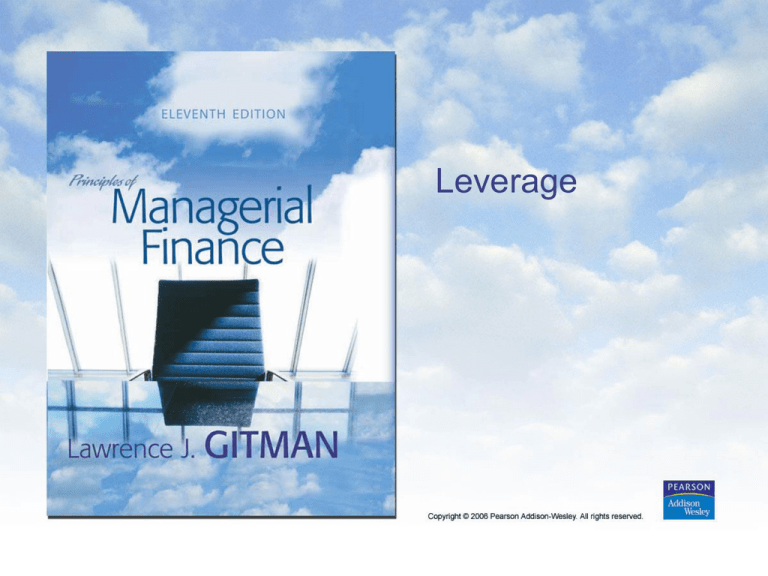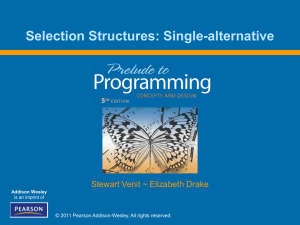
Leverage
Leverage
• Leverage results from the use of fixed-cost assets or
funds to magnify returns to the firm’s owners.
• Generally, increases in leverage result in increases in
risk and return, whereas decreases in leverage result
in decreases in risk and return.
• The amount of leverage in the firm’s capital structure—
the mix of debt and equity—can significantly affect its
value by affecting risk and return.
Copyright © 2006 Pearson Addison-Wesley. All rights reserved.
12-2
Leverage (cont.)
Copyright © 2006 Pearson Addison-Wesley. All rights reserved.
12-3
Breakeven Analysis
• Breakeven (cost-volume-profit) analysis is
used to:
– determine the level of operations necessary to cover
all operating costs, and
– evaluate the profitability associated with various
levels of sales.
• The firm’s operating breakeven point (OBP) is
the level of sales necessary to cover all
operating expenses.
• At the OBP, operating profit (EBIT) is equal to
zero.
Copyright © 2006 Pearson Addison-Wesley. All rights reserved.
12-4
Breakeven Analysis (cont.)
• To calculate the OBP, cost of goods sold and operating
expenses must be categorized as fixed or variable.
• Variable costs vary directly with the level of sales and
are a function of volume, not time.
• Examples would include direct labor and shipping.
• Fixed costs are a function of time and do not vary with
sales volume.
• Examples would include rent and fixed overhead.
Copyright © 2006 Pearson Addison-Wesley. All rights reserved.
12-5
Breakeven Analysis:
Algebraic Approach
• Using the following variables, the operating
portion of a firm’s income statement may be
recast as follows:
P
=
sales price per unit
Q
=
sales quantity in units
FC =
fixed operating costs per period
VC =
variable operating costs per unit
• Letting EBIT = 0 and solving for Q, we get:
EBIT = (P x Q) - FC - (VC x Q)
Copyright © 2006 Pearson Addison-Wesley. All rights reserved.
12-6
Breakeven Analysis:
Algebraic Approach (cont.)
Q =
Copyright © 2006 Pearson Addison-Wesley. All rights reserved.
FC
P - VC
12-7
Breakeven Analysis:
Algebraic Approach (cont.)
• Example: Cheryl’s Posters has fixed operating
costs of $2,500, a sales price of $10 per
poster, and variable costs of $5 per poster.
Find the OBP.
Q =
$2,500 = 500 posters
$10 - $5
• This implies that if Cheryl’s sells exactly 500
posters, its revenues will just equal its costs
(EBIT = $0).
Copyright © 2006 Pearson Addison-Wesley. All rights reserved.
12-8
Breakeven Analysis:
Algebraic Approach (cont.)
• We can check to verify that this is the
case by substituting as follows:
EBIT = (P x Q) - FC - (VC x Q)
EBIT = ($10 x 500) - $2,500 - ($5 x 500)
EBIT = $5,000 - $2,500 - $2,500 = $0
Copyright © 2006 Pearson Addison-Wesley. All rights reserved.
12-9
Breakeven Analysis:
Graphical Approach
Copyright © 2006 Pearson Addison-Wesley. All rights reserved.
12-10
Breakeven Analysis: Changing Costs
and the Operating Breakeven Point
Assume that Cheryl’s Posters wishes to evaluate the impact
of several options: (1) increasing fixed operating costs to
$3,000, (2) increasing the sale price per unit to $12.50, (3)
increasing the variable operating cost per unit to $7.50, and
(4) simultaneously implementing all three of these changes.
Copyright © 2006 Pearson Addison-Wesley. All rights reserved.
12-11
Breakeven Analysis: Changing Costs
and the Operating Breakeven Point
(1) Operating BE point = $3,000/($10-$5) = 600 units
(2) Operating BE point = $2,500/($12.50-$5) = 333 units
(3) Operating BE point = $2,500/($10-$7.50) = 1,000 units
(4) Operating BE point = $3,000/($12.50-$7.50) = 600 units
Copyright © 2006 Pearson Addison-Wesley. All rights reserved.
12-12
Breakeven Analysis: Changing Costs
and the Operating Breakeven Point
Copyright © 2006 Pearson Addison-Wesley. All rights reserved.
12-13
Operating Leverage
Copyright © 2006 Pearson Addison-Wesley. All rights reserved.
12-14
Operating Leverage (cont.)
Copyright © 2006 Pearson Addison-Wesley. All rights reserved.
12-15
Operating Leverage: Measuring the
Degree of Operating Leverage
• The degree of operating leverage (DOL)
measures the sensitivity of changes in EBIT to
changes in Sales.
• A company’s DOL can be calculated in two
different ways: One calculation will give you a
point estimate, the other will yield an interval
estimate of DOL.
• Only companies that use fixed costs
in the production process will experience
operating leverage.
Copyright © 2006 Pearson Addison-Wesley. All rights reserved.
12-16
Operating Leverage: Measuring the
Degree of Operating Leverage (cont)
DOL = Percentage change in EBIT
Percentage change in Sales
• Applying this equation to cases 1 and 2 in
Table 12.4 yields:
Case 1: DOL = (+100% ÷ +50%) = 2.0
Case 2: DOL = (-100% ÷ -50%) = 2.0
Copyright © 2006 Pearson Addison-Wesley. All rights reserved.
12-17
Operating Leverage: Measuring the
Degree of Operating Leverage (cont)
• A more direct formula for calculating DOL
at a base sales level, Q, is shown below.
DOL at base Sales level Q =
Q X (P – VC)
Q X (P – VC) – FC
Substituting Q = 1,000, P = $10, VC = $5, and FC = $2,500
yields the following result:
DOL at 1,000 units =
1,000 X ($10 - $5)
= 2.0
1,000 X ($10 - $5) - $2,500
Copyright © 2006 Pearson Addison-Wesley. All rights reserved.
12-18
Operating Leverage: Fixed Costs
and Operating Leverage
Assume that Cheryl’s Posters exchanges a portion of its
variable operating costs for fixed operating costs by
eliminating sales commissions and increasing sales
salaries. This exchange results in a reduction in variable
costs per unit from $5.00 to $4.50 and an increase in
fixed operating costs from $2,500 to $3,000
DOL at 1,000 units =
1,000 X ($10 - $4.50)
= 2.2
1,000 X ($10 - $4.50) - $2,500
Copyright © 2006 Pearson Addison-Wesley. All rights reserved.
12-19
Operating Leverage: Fixed Costs
and Operating Leverage (cont.)
Copyright © 2006 Pearson Addison-Wesley. All rights reserved.
12-20
Financial Leverage
• Financial leverage results from the presence of fixed
financial costs in the firm’s income stream.
• Financial leverage can therefore be defined as the
potential use of fixed financial costs to magnify the
effects of changes in EBIT on the firm’s EPS.
• The two fixed financial costs most commonly found on
the firm’s income statement are (1) interest on debt and
(2) preferred stock dividends.
Copyright © 2006 Pearson Addison-Wesley. All rights reserved.
12-21
Financial Leverage (cont.)
Chen Foods, a small Oriental food company, expects EBIT of
$10,000 in the current year. It has a $20,000 bond with a
10% annual coupon rate and an issue of 600 shares of $4
annual dividend preferred stock. It also has 1,000 share of
common stock outstanding.
The annual interest on the bond issue is $2,000 (10% x
$20,000). The annual dividends on the preferred stock are
$2,400 ($4/share x 600 shares).
Copyright © 2006 Pearson Addison-Wesley. All rights reserved.
12-22
Financial Leverage (cont.)
Copyright © 2006 Pearson Addison-Wesley. All rights reserved.
12-23
Financial Leverage: Measuring the
Degree of Financial Leverage
• The degree of financial leverage (DFL)
measures the sensitivity of changes in EPS to
changes in EBIT.
• Like the DOL, DFL can be calculated in two
different ways: One calculation will give you a
point estimate, the other will yield an interval
estimate of DFL.
• Only companies that use debt or other forms of
fixed cost financing (like preferred stock) will
experience financial leverage.
Copyright © 2006 Pearson Addison-Wesley. All rights reserved.
12-24
Financial Leverage: Measuring the
Degree of Financial Leverage (cont)
DFL = Percentage change in EPS
Percentage change in EBIT
• Applying this equation to cases 1 and 2 in
Table 12.6 yields:
Case 1: DFL = (+100% ÷ +40%) = 2.5
Case 2: DFL = (-100% ÷ -40%) = 2.5
Copyright © 2006 Pearson Addison-Wesley. All rights reserved.
12-25
Financial Leverage: Measuring the
Degree of Financial Leverage (cont)
• A more direct formula for calculating DFL at a
base level of EBIT is shown below.
DFL at base level EBIT =
EBIT
EBIT – I – [PD x 1/(1-T)]
Substituting EBIT = $10,000, I = $2,000, PD = $2,400, and
the tax rate, T = 40% yields the following result:
DFL at $10,000 EBIT =
$10,000
$10,000 – $2.000 – [$2,400 x 1/(1-.4)]
DFL at $10,000 EBIT =
Copyright © 2006 Pearson Addison-Wesley. All rights reserved.
2.5
12-26
Total Leverage
• Total leverage results from the combined
effect of using fixed costs, both operating
and financial, to magnify the effect of
changes in sales on the firm’s earnings
per share.
• Total leverage can therefore be viewed as
the total impact of the fixed costs in the
firm’s operating and financial structure.
Copyright © 2006 Pearson Addison-Wesley. All rights reserved.
12-27
Total Leverage (cont.)
Cables Inc., a computer cable manufacturer, expects sales of
20,000 units at $5 per unit in the coming year and must meet
the following obligations: variable operating costs of $2 per
unit, fixed operating costs of $10,000, interest of $20,000,
and preferred stock dividends of $12,000. The firm is in the
40% tax bracket and has 5,000 shares of common stock
outstanding. Table 12.7 on the following slide summarizes
these figures.
Copyright © 2006 Pearson Addison-Wesley. All rights reserved.
12-28
Total Leverage (cont.)
Copyright © 2006 Pearson Addison-Wesley. All rights reserved.
12-29
Total Leverage: Measuring the
Degree of Total Leverage
DTL = Percentage change in EPS
Percentage change in Sales
• Applying this equation to the data Table
12.7 yields:
Degree of Total Leverage (DTL) = (300% ÷ 50%) = 6.0
Copyright © 2006 Pearson Addison-Wesley. All rights reserved.
12-30
Total Leverage: Measuring the
Degree of Total Leverage (cont.)
• A more direct formula for calculating DTL at a
base level of Sales, Q, is shown below.
DTL at base sales level =
Q X (P – VC)
Q X (P – VC) – FC – I – [PD x 1/(1-T)]
Substituting Q = 20,000, P = $5, VC = $2, FC = $10,000, I =
$20,000, PD = $12,000, and the tax rate, T = 40% yields the
following result:
DTL at 20,000 units =
20,000 X ($5 – $2)
20,000 X ($5 – $2) – $10,000 – $20,000 – [$12,000 x 1/(1-.4)]
DTL at 20,000 units = $60,000/$10,000 = 6.0
Copyright © 2006 Pearson Addison-Wesley. All rights reserved.
12-31
Total Leverage: The Relationship of
Operating, Financial and Total Leverage
The relationship between the DTL, DOL, and DFL is
illustrated in the following equation:
DTL = DOL x DFL
Applying this to our previous example we get:
DTL = 1.2 X 5.0 = 6.0
Copyright © 2006 Pearson Addison-Wesley. All rights reserved.
12-32









